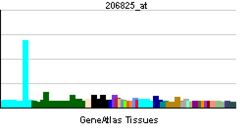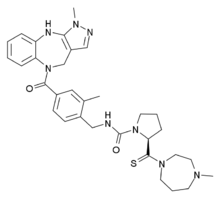- Oxytocin receptor
-
The oxytocin receptor, also known as OXTR, is a protein which functions as receptor for the hormone and neurotransmitter oxytocin.[1][2] In humans, the oxytocin receptor is encoded by the OXTR gene.,[3][4] which has been localized to human chromosome 3p25.[5]
Contents
Function and location
The OXTR protein belongs to the G-protein coupled receptor family, specifically Gq,[1] and acts as a receptor for oxytocin. Its activity is mediated by G proteins which activate several different second messenger systems.[6][7]
Oxytocin receptors are expressed by the myoepithelial cells of the mammary gland, and in both the myometrium and endometrium of the uterus at the end of pregnancy. The oxytocin-oxytocin receptor system plays an important role as an inducer of uterine contractions during parturition and of milk ejection.
Oxytocin receptors are also present in the central nervous system. These receptors modulate a variety of behaviors, including stress and anxiety, social memory and recognition, sexual and aggressive behaviors, bonding (affiliation) and maternal behavior.[8][9][10] (See the oxytocin article for more details.)
In some mammals, oxytocin receptors are also found in the kidney and heart.
Ligands
Several selective ligands for the oxytocin receptor have recently been developed, but close similarity between the oxytocin and related vasopressin receptors make it difficult to achieve high selectivity.[11][12]
Agonists
- Peptide
- Non-peptide
- Compound 39 (Ki = 33 nM, 25x selective over vasopressin receptors)[13]
- WAY-267,464 – anxiolytic in mice[12][14][15]
Antagonists
- Peptide
- Non-peptide
- Epelsiban
- GSK-221,149
- L-368,899 (CAS# 148927-60-0)[16][17]
- L-371,257 (CAS# 162042-44-6)[18][19] – peripherally selective (i.e. poor blood brain barrier penetration, few central effects)[20]
- L-372,662
- SSR-126,768
- WAY-162,720 – centrally active following peripheral administration
References
- ^ a b Gimpl G, Fahrenholz F (2001). "The oxytocin receptor system: structure, function, and regulation". Physiological Reviews 81 (2): 629–83. PMID 11274341. http://physrev.physiology.org/cgi/content/abstract/81/2/629.
- ^ Zingg HH, Laporte SA (2003). "The oxytocin receptor". Trends in Endocrinology and Metabolism 14 (5): 222–7. doi:10.1016/S1043-2760(03)00080-8. PMID 12826328.
- ^ "Entrez Gene: OXTR oxytocin receptor". http://www.ncbi.nlm.nih.gov/sites/entrez?Db=gene&Cmd=ShowDetailView&TermToSearch=5021.
- ^ Kimura T, Tanizawa O, Mori K, Brownstein MJ, Okayama H (April 1992). "Structure and expression of a human oxytocin receptor". Nature 356 (6369): 526–9. doi:10.1038/356526a0. PMID 1313946.
- ^ Simmons CF Jr, Clancy TE, Quan R, Knoll JH (19965). "The oxytocin receptor gene (OXTR) localizes to human chromosome 3p25 by fluorescence in situ hybridization and PCR analysis of somatic cell hybrids". Genomics 26 (3): 623–5. doi:10.1016/0888-7543(95)80188-R. ISSN 0888-7543. PMID 7607693. http://www.sciencedirect.com/science?_ob=ArticleURL&_udi=B6WG1-471W79Y-6P&_user=10&_coverDate=04%2F10%2F1995&_rdoc=1&_fmt=high&_orig=search&_sort=d&_docanchor=&view=c&_acct=C000050221&_version=1&_urlVersion=0&_userid=10&md5=9b00b784eb4b4ac47b1b832dfc1ecd61.
- ^ Devost D, Wrzal P, Zingg HH (2008). Oxytocin receptor signalling. "Advances in Vasopressin and Oxytocin — from Genes to Behaviour to Disease". Progress in brain research. Progress in Brain Research 170: 167–76. doi:10.1016/S0079-6123(08)00415-9. ISBN 9780444532015. PMID 18655881.
- ^ Gimpl G, Reitz J, Brauer S, Trossen C (2008). Oxytocin receptors: ligand binding, signalling and cholesterol dependence. "Advances in Vasopressin and Oxytocin — from Genes to Behaviour to Disease". Progress in brain research. Progress in Brain Research 170: 193–204. doi:10.1016/S0079-6123(08)00417-2. ISBN 9780444532015. PMID 18655883.
- ^ Caldwell HK, Young WS 3rd (2006). "Oxytocin and Vasopressin: Genetics and Behavioral Implications". In Lajtha, Abel; Ramon Lim. Handbook of Neurochemistry and Molecular Neurobiology (3rd ed.). Berlin: Springer. pp. 573–607. ISBN 0-387-30348-0.
- ^ Kiss A, Mikkelsen JD (September 2005). "Oxytocin--anatomy and functional assignments: a minireview". Endocrine Regulations 39 (3): 97–105. PMID 16468232. http://www.aepress.sk/_downloads/dl.php?from=pubmed&journal=ER&file=2005_03_97.pdf.
- ^ Veenema AH, Neumann ID (2008). "Central vasopressin and oxytocin release: regulation of complex social behaviours". Progress in Brain Research. Progress in Brain Research 170: 261–76. doi:10.1016/S0079-6123(08)00422-6. ISBN 9780444532015. PMID 18655888.
- ^ Chini B, Manning M (August 2007). "Agonist selectivity in the oxytocin/vasopressin receptor family: new insights and challenges". Biochemical Society Transactions 35 (Pt 4): 737–41. doi:10.1042/BST0350737. PMID 17635137.
- ^ a b Manning M, Stoev S, Chini B, Durroux T, Mouillac B, Guillon G (2008). "Peptide and non-peptide agonists and antagonists for the vasopressin and oxytocin V1a, V1b, V2 and OT receptors: research tools and potential therapeutic agents". Progress in Brain Research. Progress in Brain Research 170: 473–512. doi:10.1016/S0079-6123(08)00437-8. ISBN 9780444532015. PMID 18655903.
- ^ Pitt GR, Batt AR, Haigh RM, Penson AM, Robson PA, Rooker DP, Tartar AL, Trim JE, Yea CM, Roe MB (September 2004). "Non-peptide oxytocin agonists". Bioorganic & Medicinal Chemistry Letters 14 (17): 4585–9. doi:10.1016/j.bmcl.2004.04.107. PMID 15357997.
- ^ Rahman Z, Resnick L, Rosenzweig-Lipson SJ, Ring RH,"Methods of treatment using oxytocin receptor agonists", US patent application 2007/0117794, published 2007-05-24 , assigned to Wyeth Corp
- ^ Ring RH, Schechter LE, Leonard SK, Dwyer JM, Platt BJ, Graf R, Grauer S, Pulicicchio C, Resnick L, Rahman Z, Sukoff Rizzo SJ, Luo B, Beyer CE, Logue SF, Marquis KL, Hughes ZA, Rosenzweig-Lipson S (July 2009). "Receptor and behavioral pharmacology of WAY-267464, a non-peptide oxytocin receptor agonist". Neuropharmacology 58 (1): 69–77. doi:10.1016/j.neuropharm.2009.07.016. PMID 19615387.
- ^ Williams PD, Anderson PS, Ball RG, Bock MG, Carroll L, Chiu SH, Clineschmidt BV, Culberson JC, Erb JM, Evans BE (March 1994). "1-((7,7-Dimethyl-2(S)-(2(S)-amino-4-(methylsulfonyl)butyramido)bicyclo [2.2.1]-heptan-1(S)-yl)methyl)sulfonyl)-4-(2-methylphenyl)piperaz ine (L-368,899): an orally bioavailable, non-peptide oxytocin antagonist with potential utility for managing preterm labor". Journal of Medicinal Chemistry 37 (5): 565–71. doi:10.1021/jm00031a004. PMID 8126695.
- ^ Boccia ML, Goursaud AP, Bachevalier J, Anderson KD, Pedersen CA (September 2007). "Peripherally administered non-peptide oxytocin antagonist, L368,899, accumulates in limbic brain areas: a new pharmacological tool for the study of social motivation in non-human primates". Hormones and Behavior 52 (3): 344–51. doi:10.1016/j.yhbeh.2007.05.009. PMC 2712625. PMID 17583705. http://www.pubmedcentral.nih.gov/articlerender.fcgi?tool=pmcentrez&artid=2712625.
- ^ Williams PD, Clineschmidt BV, Erb JM, Freidinger RM, Guidotti MT, Lis EV, Pawluczyk JM, Pettibone DJ, Reiss DR, Veber DF (November 1995). "1-(1-[4-[(N-acetyl-4-piperidinyl)oxy]-2-methoxybenzoyl]piperidin-4- yl)-4H-3,1-benzoxazin-2(1H)-one (L-371,257): a new, orally bioavailable, non-peptide oxytocin antagonist". Journal of Medicinal Chemistry 38 (23): 4634–6. doi:10.1021/jm00023a002. PMID 7473590.
- ^ Wyatt PG, Allen MJ, Chilcott J, Foster A, Livermore DG, Mordaunt JE, Scicinski J, Woollard PM (May 2002). "Identification of potent and selective oxytocin antagonists. Part 1: indole and benzofuran derivatives". Bioorganic & Medicinal Chemistry Letters 12 (10): 1399–404. doi:10.1016/S0960-894X(02)00159-2. PMID 11992786.
- ^ Ring RH, Malberg JE, Potestio L, Ping J, Boikess S, Luo B, Schechter LE, Rizzo S, Rahman Z, Rosenzweig-Lipson S (April 2006). "Anxiolytic-like activity of oxytocin in male mice: behavioral and autonomic evidence, therapeutic implications". Psychopharmacology (Berlin) 185 (2): 218–25. doi:10.1007/s00213-005-0293-z. PMID 16418825.
External links
- MeSH Oxytocin+receptor
- "Symbol Report: OXTR". Human Geneome Organization Gene Nomenclature Committee. http://www.genenames.org/data/hgnc_data.php?hgnc_id=8529.
- "Vasopressin and Oxytocin Receptors: OT". IUPHAR Database of Receptors and Ion Channels. International Union of Basic and Clinical Pharmacology. http://www.iuphar-db.org/GPCR/ReceptorDisplayForward?receptorID=2966.
This article incorporates text from the United States National Library of Medicine, which is in the public domain.
Cell surface receptor: G protein-coupled receptors Class A:
Rhodopsin likeOtherMetabolites and
signaling moleculesOtherBile acid · Cannabinoid (CB1, CB2, GPR (18, 55, 119)) · EBI2 · Estrogen · Free fatty acid (1, 2, 3, 4) · Lactate · Lysophosphatidic acid (1, 2, 3, 4, 5, 6) · Lysophospholipid (1, 2, 3, 4, 5, 6, 7, 8) · Niacin (1, 2) · Oxoglutarate · PAF · Sphingosine-1-phosphate (1, 2, 3, 4, 5) · SuccinatePeptideOtherAnaphylatoxin (C3a, C5a) · Angiotensin (1, 2) · Apelin · Bombesin (BRS3, GRPR, NMBR) · Bradykinin (B1, B2) · Chemokine · Cholecystokinin (A, B) · Endothelin (A, B) · Formyl peptide (1, 2, 3) · FSH · Galanin (1, 2, 3) · GHB receptor · Gonadotropin-releasing hormone (1, 2) · Ghrelin · Kisspeptin · Luteinizing hormone/choriogonadotropin · MAS (1, 1L, D, E, F, G, X1, X2, X3, X4) · Melanocortin (1, 2, 3, 4, 5) · MCHR (1, 2) · Motilin · Opioid (Delta, Kappa, Mu, Nociceptin & Zeta, but not Sigma) · Orexin (1, 2) · Oxytocin · Prokineticin (1, 2) · Prolactin-releasing peptide · Relaxin (1, 2, 3, 4) · Somatostatin (1, 2, 3, 4, 5) · Tachykinin (1, 2, 3) · Thyrotropin · Thyrotropin-releasing hormone · Urotensin-II · Vasopressin (1A, 1B, 2)MiscellaneousGPR (1, 3, 4, 6, 12, 15, 17, 18, 19, 20, 21, 22, 23, 25, 26, 27, 31, 32, 33, 34, 35, 37, 39, 42, 44, 45, 50, 52, 55, 61, 62, 63, 65, 68, 75, 77, 78, 81, 82, 83, 84, 85, 87, 88, 92, 101, 103, 109A, 109B, 119, 120, 132, 135, 137B, 139, 141, 142, 146, 148, 149, 150, 151, 152, 153, 160, 161, 162, 171, 173, 174, 176, 177, 182, 183)OtherClass B: Secretin like OtherBrain-specific angiogenesis inhibitor (1, 2, 3) · Cadherin (1, 2, 3) · Calcitonin · CALCRL · CD97 · Corticotropin-releasing hormone (1, 2) · EMR (1, 2, 3) · Glucagon (GR, GIPR, GLP1R, GLP2R) · Growth hormone releasing hormone · PACAPR1 · GPR · Latrophilin (1, 2, 3, ELTD1) · Methuselah-like proteins · Parathyroid hormone (1, 2) · Secretin · Vasoactive intestinal peptide (1, 2)Class C: Metabotropic
glutamate / pheromoneOtherClass F:
Frizzled / SmoothenedFrizzledSmoothenedNeuropeptide receptors G protein-coupled receptor OtherOther neuropeptide receptorsAngiotensin · Bradykinin (B1, B2) / Tachykinin (TACR1) · Calcitonin gene-related peptide · Galanin · GPCR neuropeptide (B/W, FF, S, Y) · NeurotensinType I cytokine receptor Enzyme-linked receptor Other Neuropeptidergics Cholecystokinin Agonists: Cholecystokinin • CCK-4
Antagonists: Asperlicin • Proglumide • Lorglumide • Devazepide • DexloxiglumideCRH Agonists: Corticotropin releasing hormoneGalanin Agonists: Galanin • Galanin-like peptide • Galmic • GalnonAgonists: Galanin • Galanin-like peptide • Galmic • GalnonAgonists: Galanin • Galmic • GalnonGhrelin MCH Agonists: Melanin concentrating hormone
Antagonists: ATC-0175 • GW-803,430 • NGD-4715 • SNAP-7941 • SNAP-94847Agonists: Melanin concentrating hormoneMelanocortin Agonists: alpha-MSH • Afamelanotide • Bremelanotide • Melanotan II
Antagonists: Agouti signalling peptideAgonists: alpha-MSH • Bremelanotide • Melanotan IIAgonists: alpha-MSH • Melanotan IINeuropeptide S Agonists: Neuropeptide S
Antagonists: SHA-68Neuropeptide Y Neurotensin Opioid see Template:OpioidsOrexin Oxytocin Agonists: Carbetocin • Demoxytocin • Oxytocin • WAY-267,464
Antagonists: Atosiban • Epelsiban • L-371,257 • L-368,899Tachykinin Agonists: Substance P
Antagonists: Aprepitant • Befetupitant • Casopitant • CI-1021 • CP-96,345 • CP-99,994 • CP-122,721 • Dapitant • Ezlopitant • FK-888 • Fosaprepitant • GR-203,040 • GW-597,599 • HSP-117 • L-733,060 • L-741,671 • L-743,310 • L-758,298 • Lanepitant • LY-306,740 • Maropitant • Netupitant • NKP-608 • Nolpitantium • Orvepitant • RP-67,580 • SDZ NKT 343 • Vestipitant • VofopitantVasopressin Agonists: Desmopressin • Felypressin • Ornipressin • Terlipressin • Vasopressin
Antagonists: Conivaptan • Demeclocycline • RelcovaptanAgonists: Felypressin • Ornipressin • Terlipressin • Vasopressin
Antagonists: Demeclocycline • NelivaptanAgonists: Desmopressin • Ornipressin • Vasopressin
Antagonists: Conivaptan • Demeclocycline • Lixivaptan • Mozavaptan • Satavaptan • TolvaptanCategories:- Human proteins
- G protein coupled receptors
Wikimedia Foundation. 2010.


